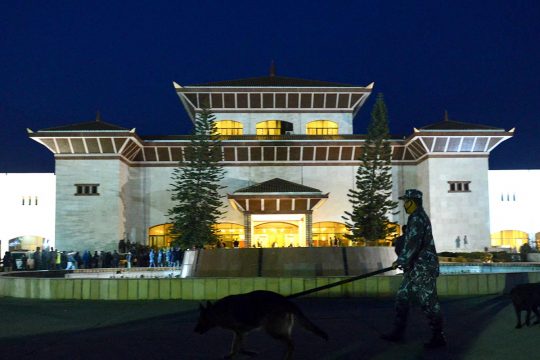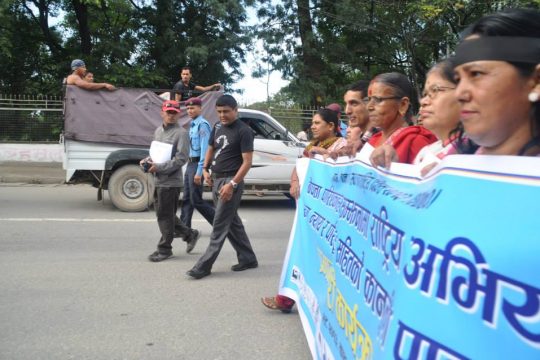The Comprehensive Peace Accord (CPA) of 2006 ended a decade of armed conflict in Nepal between the State security forces and the CPN (Maoist). With the end of the conflict that caused more than 13,000 deaths, 1,000 disappearances, displaced hundreds of thousands of people and victimized many others through torture and other human rights violations by both sides,[1] the Peace Accord spoke of a ‘new Nepal’ promising a set of transitional mechanisms to take forward political, social and economic transformation with an acknowledgement that it is necessary to address past violations of international human rights and humanitarian law. [2]
As the government introduced an Ordinance in 2013 to set up Truth and Reconciliation Commission (TRC) and the Commission on Enforced Disappearances (CIED) grossly ignoring the fundamental principles and state’s obligation on transitional justice, victims of conflict era challenged the provisions of the Ordinance in the Supreme Court. The Court gave a historic verdict with elaborated procedural recommendations for setting up TJ mechanisms that is in conformity with international standards, favoring victims’ right to seek justice.[3] The Court also made it clear that “cases that are sub-judice at various courts cannot be transferred to the Commissions”.[4] Moreover, the Court “directed that the victim’s consent should be made mandatory for reconciliation.”[5]
The Court also ruled that only the judiciary, and not the Commissions, can determine the criminality of any violations committed in the context of the country’s decade-long conflict.[6] The Court once again firmly reasserted the right of the victims of human rights violations to seek justice. This bold and principled decision was considered as a landmark move to finally end the cynical attempts by politicians from all major parties, as well as the military, to legislate impunity and shield themselves from accountability.
However, the government effectively ignored the Court order and introduced a slightly modified version of the 2013 Ordinance replicating almost all of the provisions of the TRC Ordinance, including many of its problematic aspects, such as the ‘amnesty’ provision. The process of setting up the TRC and the CIED involved minimal consultation with relatives of victims and civil society. In short, the current TRC Act was promulgated on May 11, 2014, through a compromise bill that was a revised version of the previous ordinance that the Court had struck down earlier.
The amnesty provision grants the Commissions the discretionary power to recommend amnesties for those responsible for grave violations or abuses of human rights.[7] The other key problem associated with the TRC is that it has finalized a procedure to select the insurgency-era human rights violation cases that can be put on hold on several grounds, including lack of evidence and inadequate details.[8] According to the provisions mentioned in the procedure, hundreds of conflict-era cases especially related to extra-judicial killings, torture, rape and enforced disappearances are likely to be shelved without the transitional justice mechanism conducting any inquiry. The TRC move is very much unlikely to be victim-centric. It seems the guideline has been brought with intent to ensure impunity to as many perpetrators as it desires. There is a potential danger that the doctrine of 'you keep quiet: so do I” is likely to dominate the scene if the TJ agenda is further delayed. The mindset of the parties in conflict appears to be unbending in excavating the past.
The Conflict Victims’ Common Platform, a joint forum of over a dozen conflict-victims’ groups, have expressed serious concern regarding such a move and have asked for amendment of the Acts.[9] Human rights defenders, including team INHURED have also backed conflict victims, stating that the procedure is not as per the ruling of the Supreme Court, nor does it meet international standards for transitional justice and that it obviously spells injustice for most of the conflict victims.
The general perception that dealing with past abuses is tedious, resource-consuming, risky and hostile thus should be amnestied should be tackled with public education since without truth, justice and remembrance, no society can be stable and peaceful. International experts’ advisory and technical services should be exerted to dig out evidences of concealed crimes (such as disappearance) committed by notoriously skilled hands, powerful and influential people, for their collective political aim. Grassroots peace process could be enhanced as a parallel initiative with do-no-harm approach. The international community has an obligation to influence the government to address problem of impunity and respect the legitimate work of human rights defenders, as well as curb the tendency of misinterpretation or manipulation of TJ. Human rights defenders’ groups, which are at a critical point in the legitimate battle to secure justice for the victims in a context where grave rights violators of the past have become the glorious victors of the peace process, must refrain from compromises when it is about ending impunity, seeking justice and securing reparation.
[1] UN Office of the High Commissioner for Human Rights (OHCHR), Nepal Conflict Report: An analysis of conflict-related violations of international human rights law and international humanitarian law between February 1996 and 21 November 2006, 2012, OHCHR, Geneva, p. 14, available at: http://www.ohchr.org/Documents/Countries/NP/OHCHR_Nepal_Conflict_Report2012.pdf, [accessed 10 March 2017]. The report was prepared on the basis of Transitional Justice Resource Archive (TJRA), which is a database of around 30,000 documents and cases related to the conflict.
[2] Comprehensive Peace Accord (CPA), 2006 (Bistrit Shanti Samjhauta, 2063) articles 5 (2) (4), 5 (2) (5) and 7 (1) (3). The CPA was an armistice agreement signed between the Government of Nepal and the Unified Communist Party of Nepal on 21 November 2006, that formally ended a decade long armed conflict.
[3] Ram Kumar Bhandari et al. v. President, Interim Election Council and Office of the Council of Ministers et al., Writ no. 2069-WS-0058 of the year 2069, Date of Order: April 1, 2013; Madhav Kumar Basnet et al. v. Office of the prime minister et al. NKP 2070, Decision no. 9051, p.1101.
[4] Sushil Pyakurel et al. v. Hon. Prime Minister Jhalanath Khanal et al., Writ no. 1094 of the year 2068 (2011), Date of Order: June 21, 2011; Government of Nepal on behalf of Pawankumar Patel v. Gagan Ray Yadav et al., NKP 2065, Decision no. 8003, p. 1108.
[5] Suman Adhikari et al. v. Government of Nepal, NKP 2071, Decision no. 9303, p. 2071.
[6] Govinda Prasad Sharma “Bandi” v. Attorney General Mukti Narayan Pradhan et al. NKP 2070, Decision no. 9091, pg. no. 1484.
[7] The Enforced Disapperances Enquiry, Truth and Reconciliation Ccommission Act, 2014 (Beppatta Pariyeka Byaktiko Chanbin, Satya Nirupan Tatha Melmilap Aayog Ain, 2071) s. 26.
[8] The Truth and Reconciliation Commission Rules, 2016 (Satya Nirupan Tatha Melmilap Aayog Niyamawali, 2072) rule 7.
[9] Lekhanath Pandey, ‘Conflict Victims Concerned About TRC Act Bill Amendment’, The Himalayan Times, Kathmandu, 27 September 2016, available at: https://thehimalayantimes.com/kathmandu/conflict-victims-concerned-truth-and-reconciliation-commission-act-bill-amendment/ [accessed 10 March 2017].
Berlin Seminar: Truth, Justice and Remembrance
JusticeInfo is publishing articles and testimonies from the participants to the Berlin Seminar of the Robert Bosch Stiftung, a partner of our website.
All over the world, societies suffer from traumatic experiences in wars and conflicts. The Berlin Seminar of the Robert Bosch Stiftung brings peace actors from (post-) conflict societies to Germany’s capital to work towards an appropriate approach to addressing violence in their countries. The participants discuss with experts and visit sites of memory. Furthermore, they peer-consult each other and exchange best practices to strengthen their abilities for conflict transformation. The belief is that lasting peace is only possible if the legacy of conflicts is dealt with in an inclusive and constructive manner.
Find more information here




